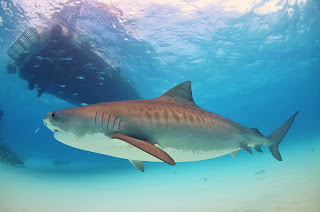Another year, another Shark Week. And as the yearly television festival of all things Shark draws to a close, we'll learn about one more of these awesome predators right here.
Tiger Sharks are one of the largest shark species, and can attain lengths of well over 10ft. They are found in tropical and subtropical oceans all around the world, but are not commonly seen.
The name given to these sharks derives from the banding pattern on their bodies. The coloring is more visible in juveniles, and fades as the sharks grow older.
Tiger Sharks are notorious scavengers and are incredibly opportunistic with their feeding. This has led them to be responsible for more attacks on humans than any shark but the Great White. Tiger Sharks are also not at all picky about what they eat (unlike the Great White), which makes them less likely to let go of their human victims and swim away.
New research also shows that Tiger Sharks take part in a practice called "Yo-Yo Diving." For a while scientists believed that this movement up and down water columns was to conserve energy, but new evidence is pointing to a different motivation: better foraging for food.
 |
| Galeocerdo cuvier |
The name given to these sharks derives from the banding pattern on their bodies. The coloring is more visible in juveniles, and fades as the sharks grow older.
Tiger Sharks are notorious scavengers and are incredibly opportunistic with their feeding. This has led them to be responsible for more attacks on humans than any shark but the Great White. Tiger Sharks are also not at all picky about what they eat (unlike the Great White), which makes them less likely to let go of their human victims and swim away.
New research also shows that Tiger Sharks take part in a practice called "Yo-Yo Diving." For a while scientists believed that this movement up and down water columns was to conserve energy, but new evidence is pointing to a different motivation: better foraging for food.
IUCN Status : Near Threatened
Location : Tropical and Subtropical Oceans Worldwide
Size : Body Length around 14ft (4.3m)
Classification : Phylum : Chordata -- Class : Chondrichthyes -- Order : Carcharhiniformes
Family : Carcharhinidae -- Genus : Galeocerdo -- Species : G. cuvier
Family : Carcharhinidae -- Genus : Galeocerdo -- Species : G. cuvier
Comments
Post a Comment